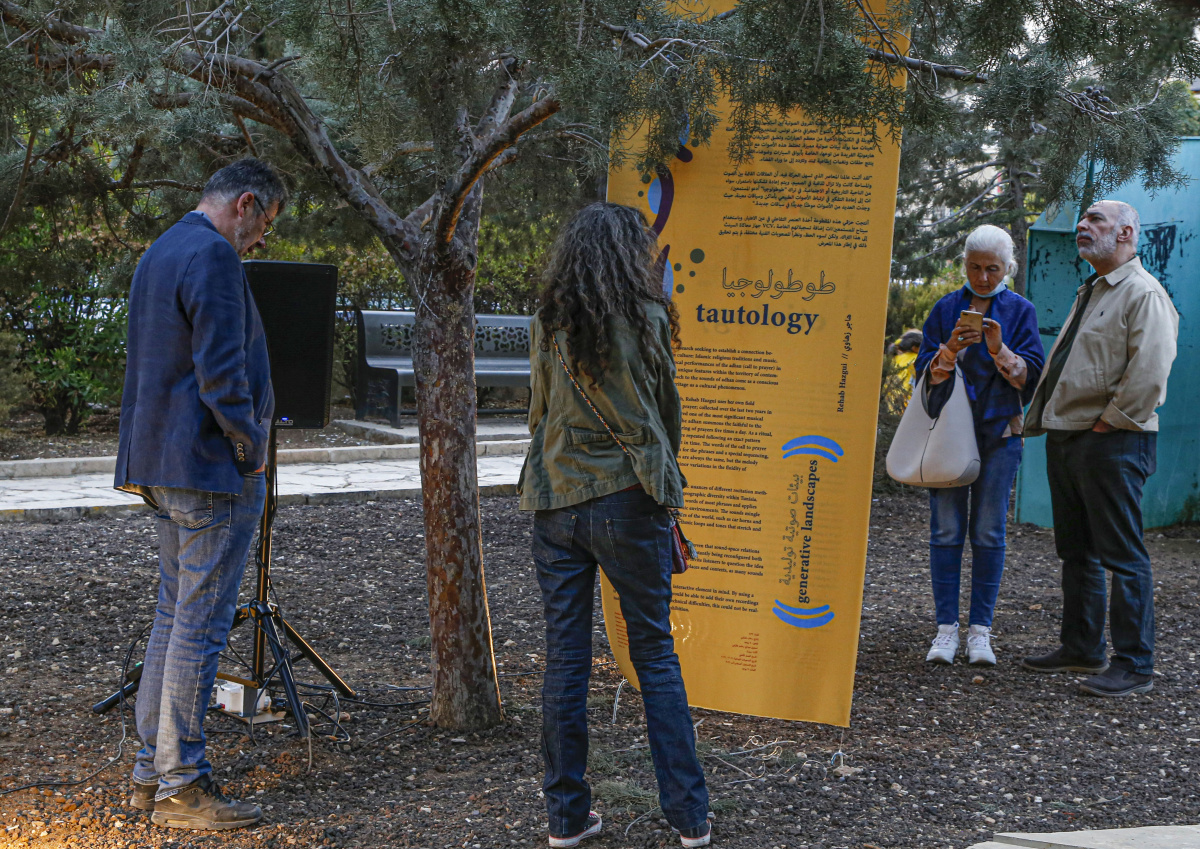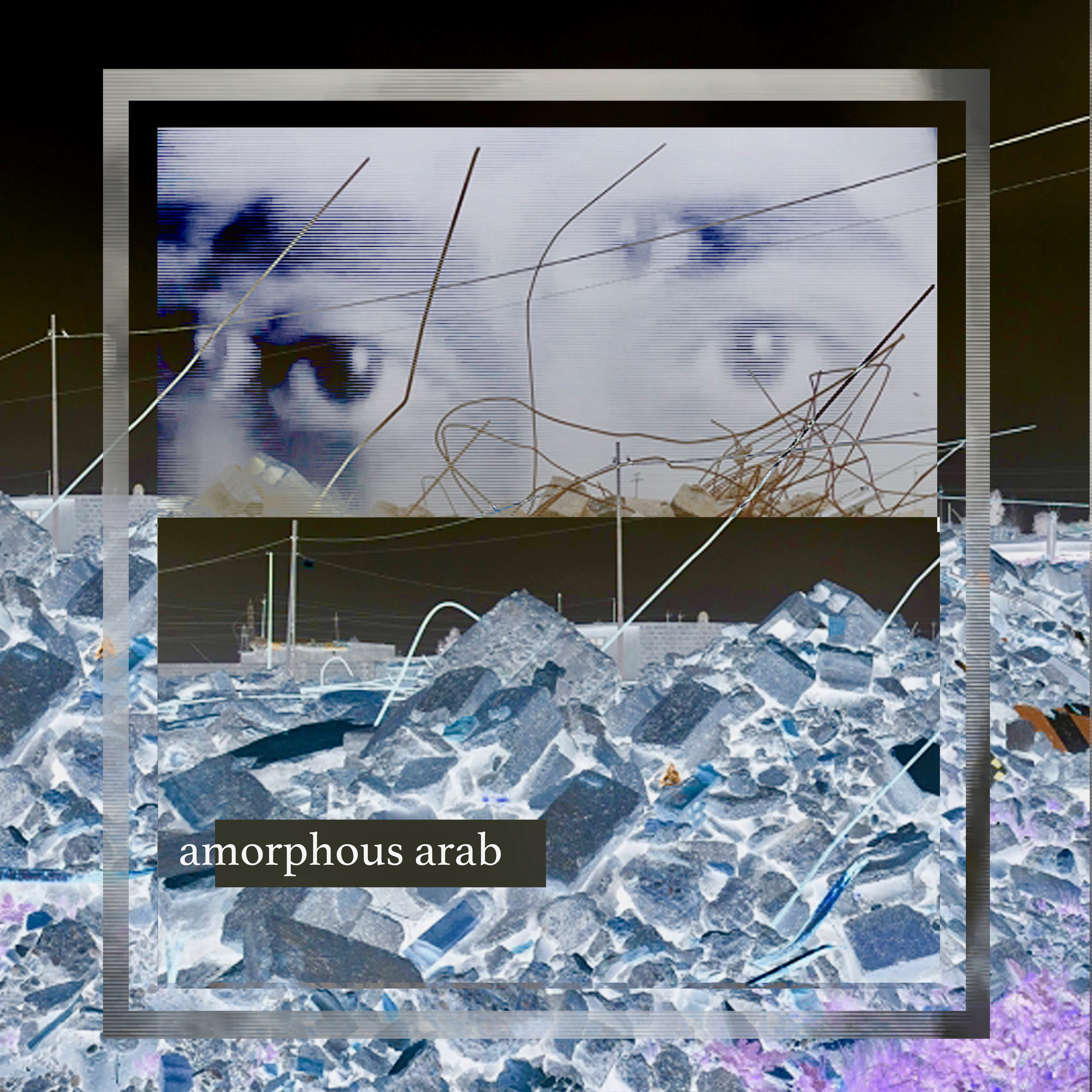
Amorphous Arab
Can one pursue the past through reimagining the present? Veteran musician Yacoub Abu Ghosh and sound experimentalist Rehab Hazgui talk to Norient about merging tradition with recent techniques at the Mirath:Music Sound Exhibition, a project by the Goethe-Institut.
For a long time, cultural practitioners took to heritage as a means of promoting a rigid identity: the way folk should be played, the way a muwashah1 should sound… the way an «Arab» should be. Yet, among those exploring the past, dialectics are emerging within rigid systems, stemming from a perception of time as bending and evolving.
Over the course of 2021, seven eclectic artists from Algeria (Amel Zen), Kurdistan-Irak (Hajar Zahawy), Jordan (Yacoub Abu Ghosh), Lebanon (Ghassan Sahhab), Palestine (Zaid Hilal), Sudan (Mohamed Adam), and Tunisia (Rehab Hazgui) gathered as part of the Mirath:Music Sound Exhibition project to explore heritage not as a spectacle of the past, but as an organic, ever-present, and ever-evolving space. These practitioners engaged with heritage as open-source, using their unique tools and schools of thought to produce authentic tracks intermingling present and past, the self and its reflection.
Shifting Structures of the Past
The work of Yacoub Abu Ghosh has been rooted in folk but was never a stranger to contemporary sound. The veteran Jordanian musician and composer, and one of the eight participants of the Mirath:Music Sound Exhibition, is well versed in folkloric productions – especially those coming out of the Levant – but creates his own blends, driven by emotional motivations. «Maqam is very much capable of being dynamic, it has and always will evolve into new directions with time.» Yacoub elaborates on how traditional Arabic scale progressions (maqam) have provided the groundwork for creative liberation, and how, contrary to their reputation as traditionalists, classical tarab2 protagonists like Umm Kulthoum actually had a visionary impact.
To that effect, Yacoub finds hybrid influences even in his most folkloric or sharqi3 productions. His last album, for instance, worked with traditional Arabic scale progressions, but also showed influences from the contemporary American Band Tool. The reason for this is the emotional complexity of the present moment, which Yacoub attempts to capture eloquently in his music. «Being an artist first of all means you have something to convey», he says.
Yacoub describes how each maqam evokes particular emotional complexities in the way it’s played. More interestingly, he describes how two musicians can play the same instrument, in the same maqam, and still have a different sound, referring to the phenomenon as «musical dialect». Yacoub gives the example of an Iraqi and an Egyptian oud player each performing maqam bayati4, pointing out that a trained ear can spot where they’re from by their respective musical accents. Yacoub explains how these geographic accents are very hard to get rid of unless a musician has radically evolved.
While many aspects of a musician’s upbringing will be imprinted in their sonic identity, their musical mediums are malleable. In his two tracks for the Mirath:Music Sound Exhibition, «Journey» – an emotional progression through maqams – and «Suleima’s Picnic» – a timeless medley of two folk songs entwined with his memories of childhood and home – Yacoub was able to blend his traditional affinities to reflect an evolving emotional identity.
The Abundant Present
If heritage lives in a transcendental space, where the past cascades into the present to create a flowing river, there is no definite point where one ends and the other begins. Capturing heritage, then, becomes a unique and authentic experience for each individual facing the water, whether for nourishment or reflection.
In the early 1990s, in the coastal city of Carthage (Tunisia), an exceptional director was about to transform traditional Soufi music in Tunis for decades to come. According to the sound experimentalist and musician Rehab Hazgui, Fadhel Al Jaziri was a «theater man» who became a driving force in Tunisian Soufi music thanks to his musicals (Nouba and Hadhra). 30 years later, in 2010, Rehab finds herself playing in a contemporary rendition of the musical, touring Tunisia with a consortium of musicians and Fadhel himself. It was a pivotal moment for Hazgui, inspiring her productions for the Mirath:Music Sound Exhibition: «I was always amazed by the openings of the show – how the first notes of the gasba or mezwed [traditional wind instruments common in Tunisian Folk] can really move everyone in the audience, thousands of people will stand up at the same time, every time. There is this connection between the audience and the gasba player, it’s a kind of catharsis. Wind instruments and dance are very connected in a magical way.»
In 2020, in preparation for the Mirath:Music Sound Exhibition, Hazgui produced «Metonymia», an experimental track attempting to transcribe tarab: the emotional peak induced in an enchanted audience by a singer’s vocals. Though she relied on a non-human actor to capture a very human moment, the Tunisian artist found that her modular synthesizer still created the required organic sound dynamic. For her contributions to the exhibition, Hazgui pushed beyond capturing the aesthetic of an ancient moment, to question the sources of influential sounds in her past through two tracks, «Etiology» and «Tautology». Her productions were composed around archival field recordings of the traditional wind instrument gasba played over the bendir drum, as well as her own field recordings of adhan, the Islamic call to prayer, captured across Tunisia.
For both tracks, Hazgui incorporated a sphere of digital and modular synthesizers that do not take part in the compositions so much as wrap them with a layer of ambiance, giving the tracks life beyond the context within which the sounds were recorded. For her, these productions were a tribute to the past, made from her present moment. Hazgui attempted to access a new space through the dynamic of her machines masking the wind: «Wind instruments are based on the breath, and breath is life; it’s the energy you translate to sound with your breath. What makes that sound so particular is the environment and the energies between people, more than the instrument itself.»
A Sip of the Ancient River
While Rehab questioned the historical sources of her influences, exploring the boundaries of familiarity under new light, Yacoub showed how conducive our inherent structures have been to this light emerging. In doing so, Rehab, Yacoub, and the other artists of the Mirath: Music Sound Exhibition deconstructed their perceptions of mirath (heritage), describing their own sip of the overflowing river, reflecting the amorphous identity of an Arab way down the stream.
- 1. The muwashah (plural muwashahat) is a complex vocal form based on classical Arabic poems from Andalusia (hence muwashahat are sometimes described as Andalusian even though their composed melodies are invariably from Syria via Egypt, and only date back a century or two). (Definition taken from maqamworld.com.)
- 2. Tarab is a reference to both a genre of classical Arabic music and the moment of «ecstasy» it evokes in the participants, as referred to by AJ Racy in his book «Making Music in the Arab World: the Culture and the Artistry of Tarab».
- 3. An overarching reference to the style of folkloric music coming out of the Arab world, from classical composition to mainstream and wedding music.
- 4. Maqam bayati is one of the most popular and common maqamat in the Arabic repertory. It is also the main maqam in the bayati family. Its scale starts with jins bayati on the tonic followed by either jins nahawand or jins rast on the 4th degree. (Definition taken from maqamworld.com.)
Norient is media partner of «Mirath:Music» (Heritage:Music), a regional touring sound exhibition in North and Northeast Africa and West Asia. The exhibition has been produced by musicians from seven different countries – Algeria, Sudan, Tunisia, Palestine, Iraq, Lebanon, and Jordan – who were invited by the Goethe-Institut to come together and explore the concept of musical heritage through sound and research.
Biography
Links
Published on December 15, 2021
Last updated on February 28, 2023
Topics
Music and art that dealing with the unfinished and undefined.
Why does a Kenyan producer of the instrumental style EDM add vocals to his tracks? This topic is about HOW things are done, not WHAT.
How artists deal with the practice that some call «time-travel» and others «audiotopia».
From westernized hip hop in Bhutan to the instrumentalization of «lusofonia» by Portuguese cultural politics.
Snap

